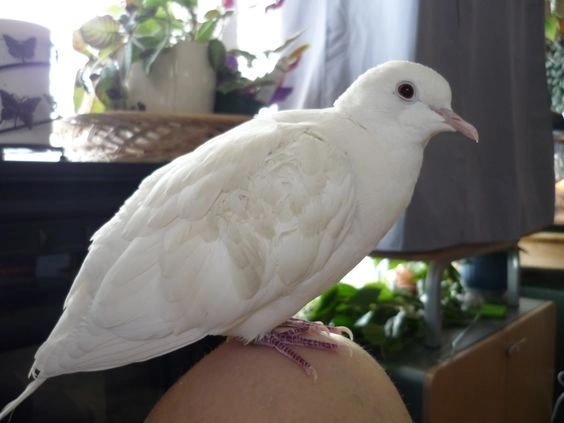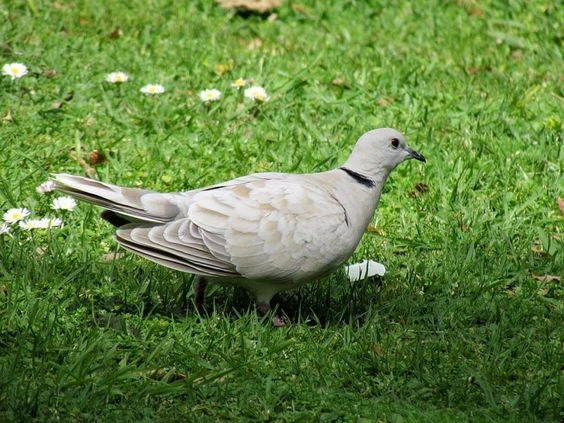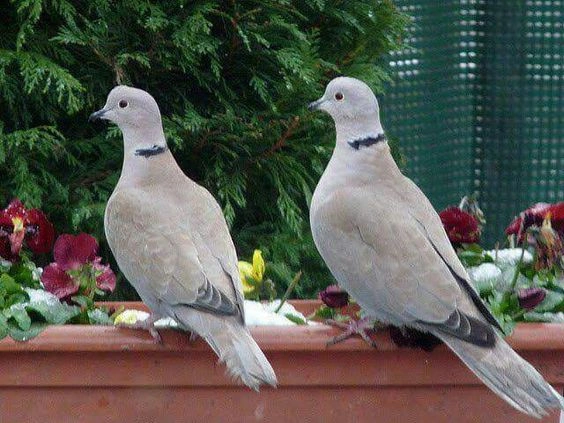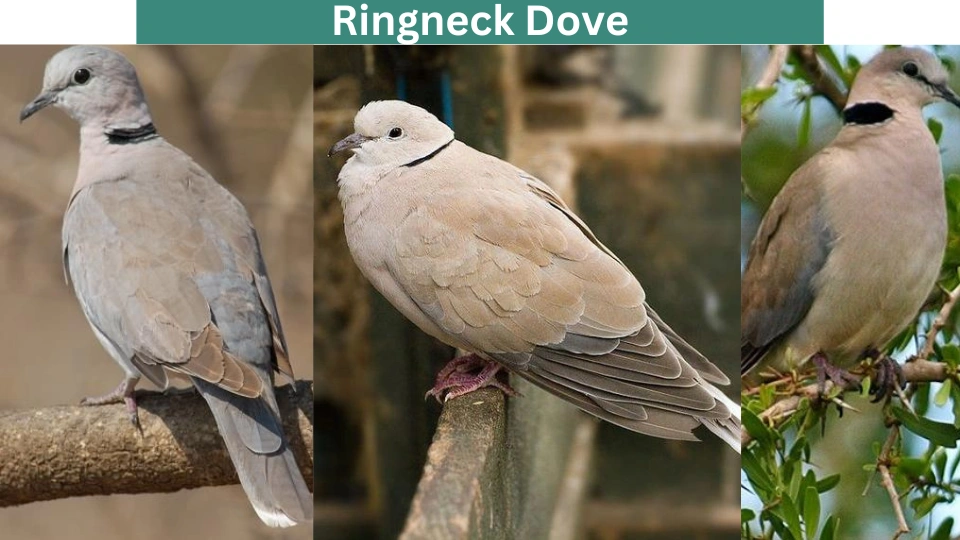Last Updated on March 17, 2024 by Aftab Tariq
The Ringneck dove, also known as the Ring-necked dove (Streptopelia capicola), is a common bird in Africa. Its name comes from the black feathers around its neck, similar to other doves in the Streptopelia family.

These doves need water to survive, so they gather in big groups near waterholes to drink and clean themselves, especially in dry areas. As pets, Ring-necked doves are friendly and easy to tame by hand.
They have a gentle nature and make soothing cooing sounds, making them great companions for those who enjoy peaceful bird sounds.
What Is A Ring-Necked Dove?
A Ringneck Dove is a bird that many people keep as a pet. They belong to the dove family and are very common pets because they have a lot of babies. Sometimes, it’s tough to stop them from having more babies. These doves are strong and healthy, so they’re a good choice for someone who doesn’t have much time to take care of a bird that needs a lot of attention.
Ringneck doves are around 12 inches long and have a soft, light brown color. They have a black ring around the back of their necks, which makes them easy to recognize. Their feet are pinkish-red, and their beaks and eyes are brown.
Where Do Ringneck Doves Come From?
Ringneck doves originally come from Africa. They’re strong birds and can be seen living freely in many Southern states like Georgia and Florida. Sometimes, you might even spot a pair of them hanging out by the side of the road.
Ringneck Dove Appearance

Ringneck doves have the darkest feathers on their upper side, colored in dull shades of grey and brown with a hint of lavender on the back of their necks. Their underside is paler with a pinkish-lavender tint, while their lower belly and the area around their cloaca (where waste is eliminated) are white.
Their tail feathers are mostly slate-grey but have noticeable white edges and tips, especially visible during their display flight. Each bird’s feathers can look different, with some lighter and others darker. Male and female doves look similar, but males are a bit larger.
Their eyes are almost black, their bills are black, and their feet are dark purple. Young doves have duller feathers without the adult’s semi-collar, and their upper feathers and wings have buff-colored edges while their underside is mostly greyish-white.
Size Of Ringneck Dove

Ringneck doves vary in size depending on their specific species. According to Gibbs, Barnes, and Cox, African-collared doves typically measure between 260 and 270 millimeters in length and weigh around 150 to 160 grams.
Meanwhile, Brown’s research on Barbary doves suggests they are slightly larger, with lengths ranging from 300 to 310 millimeters and weights varying between 150 to 200 grams. These measurements offer insight into the different sizes within the Ringneck dove family.
Caring For Ringneck Doves
Ringneck doves have different housing needs compared to parrots. They don’t climb like parrots do, so a wide cage is important for them to move around by flying. Various perch styles and sizes in their cage are good for keeping their feet healthy. Doves also need opportunities for bathing.
Unlike parrots, doves need grit because they eat seeds whole. Providing different types of grit and a calcium supplement, especially during breeding, is essential. Breeding them all year can tire them out, so giving them breaks every few months after two or three clutches is better. With proper care, ring-necked doves can live for more than ten years.
Personality & Behavior Of Ringneck Doves

Ringneck doves are gentle creatures and won’t bite or attack as some parrots might. They’re easily hand-tamed, although many owners don’t interact with them that way. These birds enjoy being in pairs and will readily breed. They’re not fussy about where they nest and might even have babies in their feeding bowl or at the bottom of their aviary.
By the time they’re a year old or even earlier, ringneck doves are ready to breed. They lay two eggs per clutch and are excellent parents, making them a good choice for beginner breeders looking for quick success. They’re also suitable pets for children, as long as the kids are gentle and calm around them and understand how sensitive birds can be.
Ringneck Dove Sounds
Ringneck doves are a good option for a bird, but your neighbors wouldn’t appreciate a noisy parrot. They make cooing sounds similar to pigeons, which are not loud but can be consistent. Some people find their cooing calming, while others might find it annoying because they rarely stop.
Health And Common Issues Of Ringneck Doves
Ringneck doves can face health problems like red mites and tiny bugs that hide during the day and come out at night to bite the bird and drink its blood. Doves living outside can also get worms like roundworms and tapeworms.
Canker is another concern, a sickness that swells the dove’s throat and causes a strange-looking growth around its mouth.
If not treated, canker can be deadly. People caring for doves need to be careful because they can pass on infections like Chlamydia and Salmonella. So, washing hands after handling, feeding, or cleaning the dove’s home is important.
Wild Populations Of Ringneck Doves

There are more than 40 varieties of ring-necked doves in the wild, some of which are white or have mixed colors. However, the ones with fawn color are the most common and easiest to find, especially from breeders. These birds are inexpensive, usually ringneck dove price between $10 to $30 for a pair. Some mutations are pricier, but generally, they’re quite affordable.
Are Ringneck Doves Rare?
Ringneck doves, called Cape turtles or half-collared doves are not considered rare. They are found in East and southern Africa and are quite common there. These doves prefer to stay in one area and are seen in many open places.
On the other hand, Mourning Doves are very common in North America. They are the most widespread and abundant game birds in the region. Hunters catch more than 20 million of them yearly, yet their population remains very high, with an estimated 350 million in the United States alone.
Ringneck Dove Male Vs Female
The difference between male and female ringneck doves, also known as Barbary doves, can be tricky, even for experienced bird enthusiasts. However, you can use a few methods to determine if your doves are boys or girls.
Both males and females look very similar, but males are larger. They measure around 9.8 to 10.4 inches in length and weigh between 3.2 to 6.6 ounces. Their eyes are nearly black, their bills are black, and their feet are dark purple.
When they’re young, they’re not as colorful and don’t have the distinct markings around their necks that adults do.
What Does Ring-Necked Dove Eat?
Their diet often includes seeds, fruit, berries, and even insects. They even consume insects on occasion.
The ring-necked dove is a versatile bird that can also tolerate human disturbances. Their population is constantly growing.
Frequently Asked Questions
What Is Ringneck Dove Lifespan?
The average longevity of ringneck doves kept in human care is 12 years.
Where Do Ringneck Doves Live?
Ringneck doves inhabit eastern and southern Africa.
I am a dedicated content writer with more than five years of experience, particularly skilled in the art of storytelling. My writing journey commenced during my college years, where I pursued journalism and unearthed my talent for creating captivating narratives.


